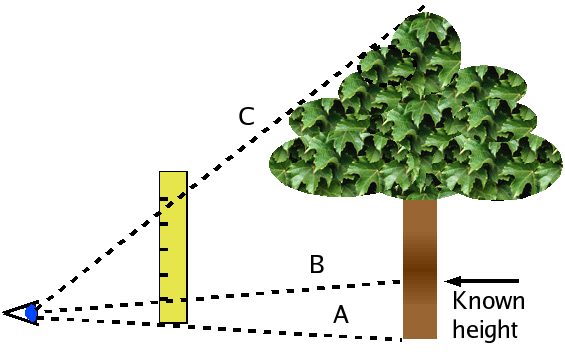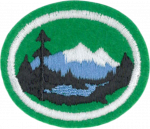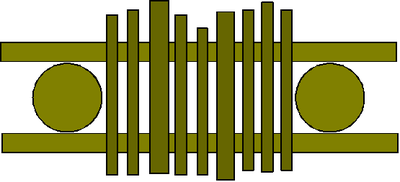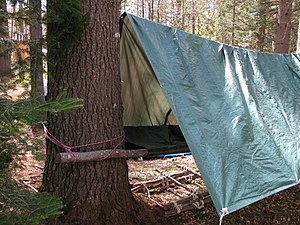Especialidades JA/Vida primitiva/Respuestas
| Vida primitiva | ||
|---|---|---|
| Asociación General
|
Destreza: 2 Año de introducción: 1956 |
|
Requisitos
|
La especialidad de Vida primitiva es un componente de la Maestría Vida Primitiva. |
| Conexión Logros para la Investidura: Esta especialidad está relacionada con los requisitos de Logros para la Investidura para GUÍA DE NUEVA FRONTERAS Vida al Aire Libre que requiere el desarrollo completo de esta especialidad o de 4 otras especialidades, no obtenidas previamente. |
1
Estos campamentos se pueden hacer con su Club de Conquistadores, con su familia o con amigos. También debe hecharle un vistazo a los requisitos de la especialidad de Pionerismo, porque tal vez podrá completar las dos especialidades en los dos viajes.
2
Qué hacer cuando perdido
Adventist Youth Honors Answer Book/Camping/Lost/es
Determinar la dirección sin brújula
Adventist Youth Honors Answer Book/Camping/No compass/es
3
4
Capturar agua de lluvia
Esta es probablemente la forma más sencilla de recolectar agua potable, si es que llueva mientras acampa. Para atrapar agua, simplemente estire una lona limpia entre los árboles de tal manera que la lona sea en su mayoría horizontal. Mientras llueve, el agua saldrá de la lona, usualmente en una corriente. Coloque un recipiente debajo de esta corriente y espere hasta que se llene.
Capturar el rocío
Puede atrapar el rocío de la mañana extendiendo una lona limpia sobre el suelo. Si cae un rocío durante la noche, puede recoger el agua absorbiéndola con una toalla de papel y retorciéndola sobre un recipiente. Si olvida poner una lona la noche anterior, o si no tiene una lona, aún puede recoger rocío. Envuelva una camiseta (u otra pieza de tela) alrededor de las perneras de su pantalón, y luego camine a través de la hierba húmeda. Cuando la camiseta esté suficientemente mojada, escúrrela sobre un recipiente.
Destilación solar
La destilación solar puede usarse para extraer agua pura de casi todo lo que está mojado. Comience cavando un hoyo de 25 cm de profundidad. Coloque un recipiente pequeño en el centro del orifihoyocio; esto atrapará el agua. Coloque la materia húmeda (cactus picados, hojas mojadas, etc.) en el hoyo alrededor del recipiente y luego cubra el hoyo con una lámina de plástico transparente. Ancle las orillas de la lámina de plástico para que no se deslice dentro del hoyo y coloque un pequeño peso (como una piedra pequeña) en el centro de la lámina. Este peso debe estar situado directamente sobre el centro del recipiente. A medida que la luz del sol penetra la lámina, evapora el agua del material húmedo en el hoyo. El vapor de agua se eleva hasta que alcanza la lámina, donde se condensa. A medida que el agua se acumula en la parte inferior de la lámina, corre cuesta abajo hasta el peso donde gotea y, con un poco de suerte, cae dentro del recipiente. Esto incluso funcionará con la orina (pero reserva eso para una emergencia real).
De cuerpos de agua dulce
También puede recoger el agua de los cuerpos de agua dulce como los ríos, manantiales y lagos, pero esta agua debe ser purificada antes de usar.
Nieve derretida
Si se encuentra en un área que tiene nieve, puede recogerla y derretirla en una olla. Se derretirá más rápida si hay un poco de agua en estado líquido en la olla. No coma la nieve, ya que esto reducirá su temperatura corporal interna y aumentará el riesgo de la hipotermia.
5
La razón principal para querer estimar la altura de un árbol y la anchura de una corriente sería para que pueda cortar un árbol y usarlo como un puente para cruzar la corriente. Por supuesto, un Conquistador responsable «nunca» haría esto sin permiso del propietario del terreno, y hasta con eso, sólo después de una cuidadosa consideración. ¡Qué desafortunado para usted, sin embargo, si cortó un árbol que no era lo suficientemente alto para atravesar la corriente, y qué desperdicio de un buen árbol si era demasiado largo!
Estimación de altura, método 1

En el primer método presentado aquí, necesitará una regla o cualquier objeto con marcas espaciadas uniformemente. Camine hasta el árbol y calcule un punto en él que es una altura matemáticamente conveniente desde el suelo (por ejemplo, cinco pies o dos metros). Marque ese punto para que pueda verlo claramente desde una distancia atando una cuerda alrededor del árbol a esa altura.
Luego, aléjese del árbol para que pueda ver su parte superior. Sostenga la regla en frente de su cara, de manera que la línea de visión desde su ojo hasta la base del árbol cruce la marca «0» en la regla. Esta es la línea A en el diagrama. Luego, mueva la regla hacia o lejos de su ojo hasta que la línea que va de su ojo a la cuerda que ató al árbol cruce la marca «1» en la regla. Esta es la línea B en el diagrama. Cuando la regla esté colocada correctamente de modo que las líneas A y B apunten a la base y la altura conocida, mire hacia arriba y observe la medida en la que la línea desde su ojo hasta la parte superior del árbol (línea C en el diagrama) cruza la regla. Haga esto sin mover la regla o su cabeza. Cuando tenga esta medida, multiplíquela por la altura matemáticamente conveniente que seleccionó al principio. Esta es la altura del árbol.
Por ejemplo, suponga que selecciona 2 metros como la altura conocida del árbol y la línea C cruza el punto 4.5 en la regla:
[math]\displaystyle{ altura = 4.5\times 2 metros = 9 metros }[/math]
Tenga cuidado de no meterse en el ojo con la esquina del papel. De hecho, sería prudente cortar la esquina. El ángulo seguirá siendo correcto aun sin él.
Cuando la parte inferior del papel apunta hacia la parte inferior del árbol, y el pliegue en el papel apunta hacia la copa del árbol, la distancia entre usted y el árbol es igual a la altura del árbol. Estime esta distancia usando sus pasos. Cada dos pasos es aproximadamente 1 metro y medio (lo que significa que cada cuarto paso es aproximadamente 3 metros). Para mejor precisión, mida su paso y use esa medida.
6
7
8
9
- Knife
- A knife has many uses in a survival situation. It can be used for making fuzz sticks or wood shavings for tinder, carving wooden utensils, cutting cloth, cleaning fish, etc. Its use is limited only by your imagination.
- Waterproof matches in a waterproof container
- If it gets cold, you will need to light a fire. A fire is also necessary for boiling water (which is one way to purify it).
- Metal cup
- A metal cup (or a tin can) can be used to hold water while you boil it. It can also be used as a pot for cooking food, and as a dish for eating.
- Flint or other firestarter
- A magnesium block with a flint is an ideal backup for the matches.
- Compass
- The needle of a compass points to magnetic north.
- Map
- If you have a map of the area you're in as well as a compass, you should be able to find out where you are and find your way out.
- Watch
- A watch can be used as a compass too.
- Waterproof ground cloth and cover
- This will help you stay dry, and staying dry is critical for staying warm.
- Flashlight
- Binoculars
- Useful for spotting game, rescue craft, rescue parties, etc.
- Whistle
- A whistle can be used for signaling a rescue party. It is far louder than your voice and can be heard even at great distances. Give three blasts on it to signal for help.
- Fatty emergency foods
- Nuts, peanut butter, chocolate, etc., are high in fat. Fatty foods are packed with calories, and if it gets cold, your body can convert calories into heat.
- Food gathering gear
- Signaling items
- Rope
- Many uses, especially in building a shelter, or climbing.
- Emergency blanket
- Emergency blankets (sometimes called space blankets) are very lightweight, foil-like sheets that reflect up to 90% of a persons body heat back towards the person. Cover yourself with it at night.
- Aluminum foil
- Can be used for cooking, or even shaped into a crude cup for boiling water.
10
Adequate sleep, proper diet, personal hygiene, and proper exercise are all important for keeping the mind and body in tip-top shape. When you are in a wilderness situation, it is important to be in good condition, because if you need emergency medical assistance, it will not be easy to get. Keeping your mind sharp will help you make good judgment calls, and that, in turn, will help prevent you from a foolish accident. Keeping your body in shape will also help you avoid sprains, falls, and other accidents.
11
Para consejos e instrucciones, véase Primeros auxilios II.
11a
11b
11c
11d
11e
11f
11g
11h
12
13
In order to come close to an animal, trackers must remain undetected not only by the animal, but also by other animals that may alert it. Moving as quietly as possible, trackers will avoid stepping on dry leaves and twigs, and take great care when moving through dry grass.
If the trackers are in close proximity to the animal, it is important that they remain downwind of it, that is, in a position where the wind is blowing away from the animal in the direction of the tracker. They must never be in a position where their scent could be carried in the wind towards the animal and thereby alert it. It is also important that the animal does not have the opportunity to cross their tracks, since the lingering human scent will alert it. Most animals prefer to keep the wind in their faces when traveling so that they can scent danger ahead of them. Trackers will therefore usually be downwind from them as they approach the animals from behind. The wind direction may, however, have changed. If the wind direction is unfavorable, the trackers may have to leave the spoor (tracks and other indications of an animal's presence) to search for their quarry from the downwind side.
As the trackers get closer to the animal, they must make sure that they see it before it sees them. Some trackers maintain that an animal keeps looking back down its own trail, always on the alert for danger coming from behind. When the spoor is very fresh, trackers may have to leave the spoor so that the animal does not see them first. Animals usually rest facing downwind, so that they can see danger approaching from the downwind side, while they can smell danger coming from behind them. An animal may also double back on its spoor and circle downwind before settling down to rest. A predator following its trail will move past the resting animal on the upwind side before realizing that the animal had doubled back, and the resting animal will smell the predator in time to make its escape.
When stalking an animal, trackers use the cover of bushes, going down on their hands and knees where necessary. In long grass they go down on their stomachs pulling themselves forward with their elbows. The most important thing is not to attract attention by sudden movements. Trackers should take their time, moving slowly when the animal is not looking, and keeping still when the animal is looking in their direction. When stalking an animal, trackers must also be careful not to disturb other animals. A disturbed animal will give its alarm signal, thereby alerting all animals in the vicinity, including the animal being tracked down.
Text from The Art of Tracking: The Origin of Science, by Louis Liebenberg, with permission from the author. Taken from Wikipedia:Tracking (hunting)
14
In a survival situation, the most important thing for a stranded person to do is find or build a shelter. This is more important than water, fire, or food. The rule of threes tells us that a person can survive for three hours without shelter, three days without water, and three weeks without food. In most wilderness fatalities, the victims die from exposure to the elements. They do not die of thirst, nor do they die of starvation. Unless rescue is expected to take more than three days, the victims need not consider water or food - only shelter. They key to being found and rescued is to stay put, and keep warm.
14a
In deep snow, you can dig a snow cave and use that for shelter. Try to make a sleeping platform higher than the floor, as this will keep you warmer. Place something on top of the platform so that you do not sleep directly on the snow. Leaves, pine needles, or if you have one, a sleeping pad will all work well for this. Block the opening with a backpack.
If the snow is not deep enough, you can build a quinzhee, which is similar to an igloo, but less time-consuming to build. Start by piling any gear you can do without for a few hours in a heap, and then start shoveling snow on top of it. It may take a while to dig the gear out again, so be careful about what you bury. The mound of snow needs to be at least 2.5 meters![]() wide, and 2 meters
wide, and 2 meters![]() high. Once the snow is in place, let is sinter for an hour or two. Cook your supper, or go on a hike. Sintering is the process of the snow particles binding to one another. Once enough time has elapsed, gather some sticks and break them into 30 cm
high. Once the snow is in place, let is sinter for an hour or two. Cook your supper, or go on a hike. Sintering is the process of the snow particles binding to one another. Once enough time has elapsed, gather some sticks and break them into 30 cm![]() lengths. Insert the sticks fully into the snow dome. These will serve as wall thickness indicators when you begin hollowing out the inside.
lengths. Insert the sticks fully into the snow dome. These will serve as wall thickness indicators when you begin hollowing out the inside.
Begin digging a door, and tunnel in until you reach the pile of gear in the center. Then extract the gear. Having the gear inside is not strictly necessary, but it reduces the amount of digging you have to do. Shed a few layers when you dig, because this will cause you to work up a tremendous sweat. As soon as the quinzhee is finished, you should change into some dry clothing (otherwise, you may be calling an emergency rescue crew to deal with a severe case of hypothermia). Hollow out the inside, stopping as soon as you hit the sticks. Smooth the walls as you go. This is important, because if the walls are smooth, as the snow inside melts, it will run down the walls. If the snowmelt finds a point, it will form a drip. There is nothing adventurous about having a drip of ice cold water landing on your neck at 3:00 am.
Finally, cut three or four vent holes in the ceiling. This will allow stale air to escape. The vent holes need only be 5 cm![]() in diameter, but they must be made, or you will be re-breathing the C02 you exhaled previously. If you plan to light a candle inside, the vents are even more important, as they will allow carbon monoxide to escape.
in diameter, but they must be made, or you will be re-breathing the C02 you exhaled previously. If you plan to light a candle inside, the vents are even more important, as they will allow carbon monoxide to escape.
As with the snow cave, make a smooth sleeping platform. The coldest air in the quinzhee will find the lowest point inside, and that is not where you will want to sleep. Again, block the entry with a backpack.
14b
A shelter does not have to be tall enough to stand up inside, nor does it even need to be tall enough to sit up inside. It will, however need to be tall enough for you to lie inside. 40 cm![]() should be plenty. Start by gathering stones, and build two walls as high as you want the shelter to be. Unless you are a skilled stone layer, the walls should be at least as wide as they are tall. The two walls should be parallel to one another, a little longer than you are, and about twice as wide as your shoulders and hips. When the walls are finished, throw a tarp over them. The tarp should cover the fine walls you just built and lie on the ground on either side. Pile more rocks on the part of the tarp that is lying on the ground. If you can find a stick a little taller than the wall, use it to hold one end of the tarp (near an open end) higher than the rest of the structure. This will create a slope so that water will run off rather an collect on the tarp. (If enough collects on the tarp, your roof will most certainly collapse.)
should be plenty. Start by gathering stones, and build two walls as high as you want the shelter to be. Unless you are a skilled stone layer, the walls should be at least as wide as they are tall. The two walls should be parallel to one another, a little longer than you are, and about twice as wide as your shoulders and hips. When the walls are finished, throw a tarp over them. The tarp should cover the fine walls you just built and lie on the ground on either side. Pile more rocks on the part of the tarp that is lying on the ground. If you can find a stick a little taller than the wall, use it to hold one end of the tarp (near an open end) higher than the rest of the structure. This will create a slope so that water will run off rather an collect on the tarp. (If enough collects on the tarp, your roof will most certainly collapse.)
14c
The main function of a shelter in a swamp or marsh is to get you off the ground. To do this, you will need to build a platform. This can be constructed by finding two trees at least 20 cm![]() in diameter and about 2.5 meters
in diameter and about 2.5 meters![]() apart. Then using square lashing, attach two long poles to either side of the trees, high enough to keep you out of the muck. Use continuous lashings to lash several shorter poles across the support poles to make the platform surface. The short poles should all be as close to the same diameter as possible, or if that's impossible, arranged from smallest to largest. Be diligent when making the lashings, checking and double checking the tightness of the ropes. The lashings must be sufficient to hold your weight.
apart. Then using square lashing, attach two long poles to either side of the trees, high enough to keep you out of the muck. Use continuous lashings to lash several shorter poles across the support poles to make the platform surface. The short poles should all be as close to the same diameter as possible, or if that's impossible, arranged from smallest to largest. Be diligent when making the lashings, checking and double checking the tightness of the ropes. The lashings must be sufficient to hold your weight.
As a more comfortable alternative to using continuous lashing to attach cross bars, you can instead use a tarp as a platform. It is constructed the same way you would build an improvised litter (stretcher) as described in the Basic Rescue honor. If you have a tarp, you will also probably have enough to stretch it over the platform as well creating walls and a roof to keep the weather at bay.
14d
It is somewhat odd that forests and tundra are grouped together in this requirement. A forest is by definition, an abundance of trees, while a tundra is an area where the tree growth is hindered by low temperatures and short growing seasons. They are geographical opposites.
In a forested area, build a lean-to. This is done by finding two trees about 2 meters![]() apart, and lashing a horizontal pole to them, about 1.3 meters
apart, and lashing a horizontal pole to them, about 1.3 meters![]() from the ground. Then find more poles, and lay one end of each on the horizontal pole, and the other end on the ground. This will take several poles, as they should be lain side-by-side all the way across. Finally, cover the poles with a layer of debris - leaf litter, twigs, moss - whatever you can find.
from the ground. Then find more poles, and lay one end of each on the horizontal pole, and the other end on the ground. This will take several poles, as they should be lain side-by-side all the way across. Finally, cover the poles with a layer of debris - leaf litter, twigs, moss - whatever you can find.
In tundra, use the techniques for building a shelter in the snow, or if there is no snow, use the techniques for building a shelter in a rocky area.
15
16
17
17a
17b
17c
17d
17e
17f
17g
17h
17i
References
- Categoría: Tiene imagen de insignia
- Adventist Youth Honors Answer Book/Honors/es
- Adventist Youth Honors Answer Book/es
- Adventist Youth Honors Answer Book/Skill Level 2/es
- Categoría: Libro de respuestas de especialidades JA/Especialidades introducidas en 1956
- Adventist Youth Honors Answer Book/General Conference/es
- Adventist Youth Honors Answer Book/Recreation/es
- Adventist Youth Honors Answer Book/Recreation/Primary/es
- Adventist Youth Honors Answer Book/Stage 75/es
- Adventist Youth Honors Answer Book/Wilderness Master Award/es
- Adventist Youth Honors Answer Book/IAConnection/es
- AY Honors/Prerequisite/First Aid, Standard/es
- AY Honors/See Also/First Aid, Standard/es
- Adventist Youth Honors Answer Book




